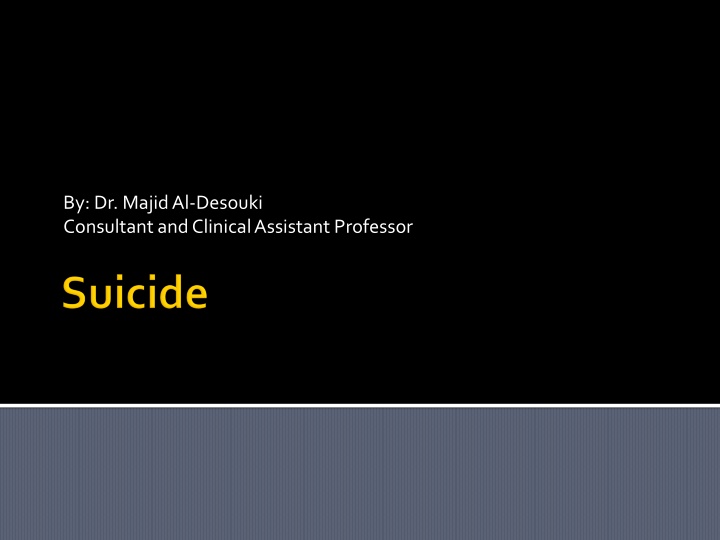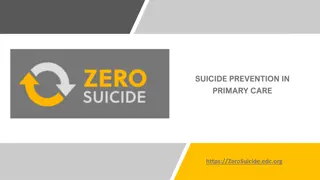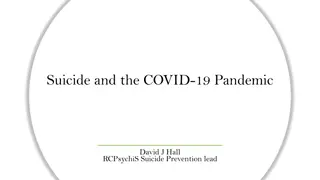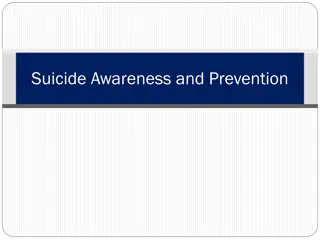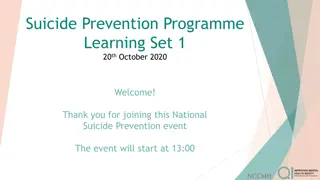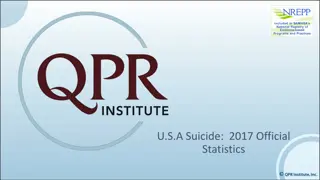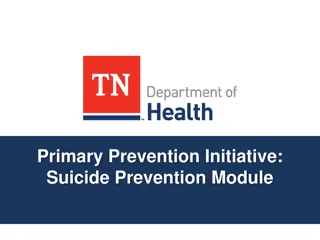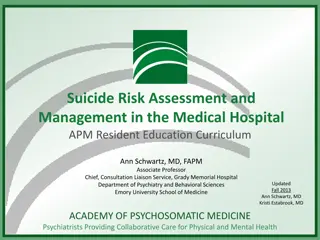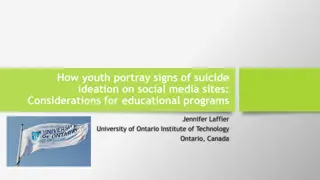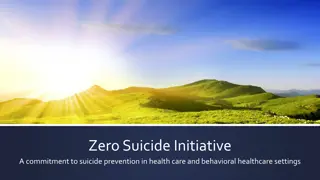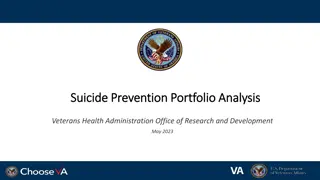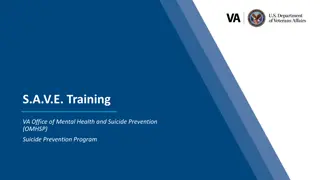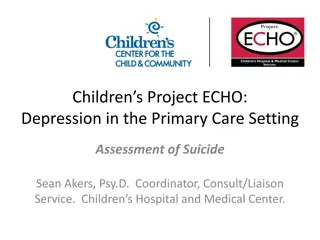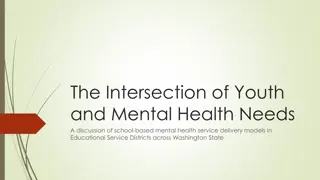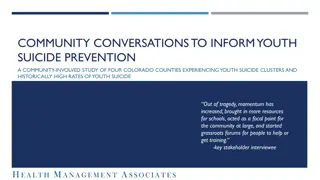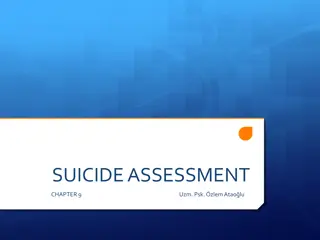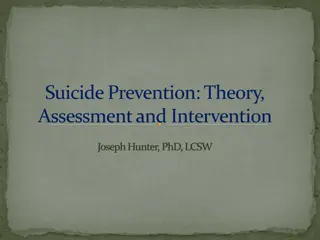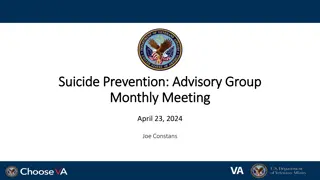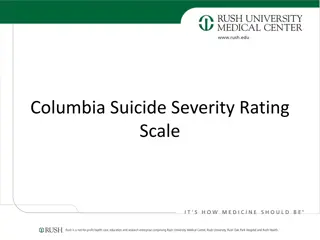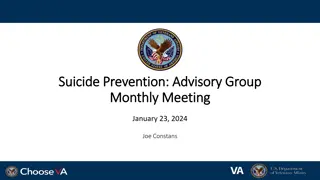Suicide Risk Factors and Prevention Strategies
Understanding the risk factors and warning signs of suicide, as well as the importance of proper assessment and intervention to prevent such tragic outcomes. Explore the common demographics and conditions associated with suicide, along with effective prevention strategies and treatment options.
Download Presentation

Please find below an Image/Link to download the presentation.
The content on the website is provided AS IS for your information and personal use only. It may not be sold, licensed, or shared on other websites without obtaining consent from the author.If you encounter any issues during the download, it is possible that the publisher has removed the file from their server.
You are allowed to download the files provided on this website for personal or commercial use, subject to the condition that they are used lawfully. All files are the property of their respective owners.
The content on the website is provided AS IS for your information and personal use only. It may not be sold, licensed, or shared on other websites without obtaining consent from the author.
E N D
Presentation Transcript
By: Dr. Majid Al-Desouki Consultant and Clinical Assistant Professor
Depressive disorder Substance abuse Schizophrenia Personality disorder Serious chronic physical disease old age Social isolation and lack of support Financial problems
Hanging Shooting Burning Poisoning Rushing in front of running vehicles Jumping from high places
About half of suicides preceded by attempt 23 x more likely to die later Females attempt much more Males 4 x more likely to die
Age > 45 years old Male > Female Separated, divorced, widow > single > married Previous suicide attempts or behavior Family history of suicide behavior Current psychopathologic conditions: Severe depression/Substance abuse/Psychosis/Personality disorder Concurrent serious or chronic medical condition. Lack of social support Suicide note Planning with precautions against discovery Strong intent to die
Evaluation of intentions History of intentional self-harm Presence of mental disorders Presence of adverse social and medical conditions Presence of homicidal ideation
Proper assessment Should be taken very seriously Hospitalization Prevent access to all means of harm Appropriate observation Treat any psychiatric disorder (ECT/medications) Less risk: Counseling/support/treatment & fu
Definition: any act of self-damage carried out with the apparent intention of self- destruction; yet ineffective, half-hearted and vague. Etiology: Impulsive behavior: seen commonly in BPD Unconscious motives: to influence others, a signal of distress or a cry for help (histrionic PD) Failed suicide: 25 % of cases. Risks Factors: young (15 35 years), females, PD, and situational stress
Overdose (e.g. paracetamol) most common Self-injury e.g. laceration of wrist Jumping from heights Full assessment Treat psychiatric disorder Problem solving and counseling Prolonged f/u
By: Dr. Majid Al-Desouki Consultant and Clinical Assistant Professor
Aggression feeling of anger or antipathy resulting in hostile or violent behavior, readiness to attack or confront The aggressive patient usually presents as a danger to others, to property and sometimes to himself Aggression could occur in the A/E, OPD either psychiatry or others, the hospital ground or the wards, therefore the policy applies to all these situations accordingly.
Usuallythe majority of psychiatric patients are not hostile, dangerous or aggressive, BUToccasionally psychiatric illness presents with Aggressive Behavior
Brief psychosis /schizophreniform disorder/acute schizophrenia Substance abuse (intoxication / withdrawal) Acute confusional state (e.g. delirium), brain conditions and dementia Mood disorders; mania -severe agitated depression Personality disorders (e.g. borderline personality disorder)
Arrange for adequate help Appear calm and helpful Avoid confrontation Take precautions: Never attempt to evaluate an armed patient Other persons should be present (security guards or police officers) Keep the door open for an unavoidable exit Restraints if needed by an adequate number of people using the minimum force Carefully search for any kind of offensive weapon Aim to save patient and others Anticipate possible violence from hostile, threatening behavior and from restless, agitated abusive patient Do not bargain with a violent person about the need for restraints, medication or psychiatric admission Reassure the patient and encourage self-control and cooperation
Enough staff One team member to pts head and each extremity. Humane but firm, and do not bargain, start together to hold the patient and accomplish restraint quickly.
Not as a punishment For the safety of pt., staff, property & others On time-out basis Regular check up on the pt. Attend for the pt. basic needs Evaluation of the condition by dr. Monitor pt. through a screen.
Major Tranquilizers e.g. : Olanzapine 5-10mg IM, (Haloperidol 5 -10 mg IM or Chlorpromazine 50 -100 mg IM.) Benzodiazepines:e.g. diazepam 5-10 mg (slow IV infusion to avoid the risk of respiratory depression). Hospitalization: For further assessment and treatment.
